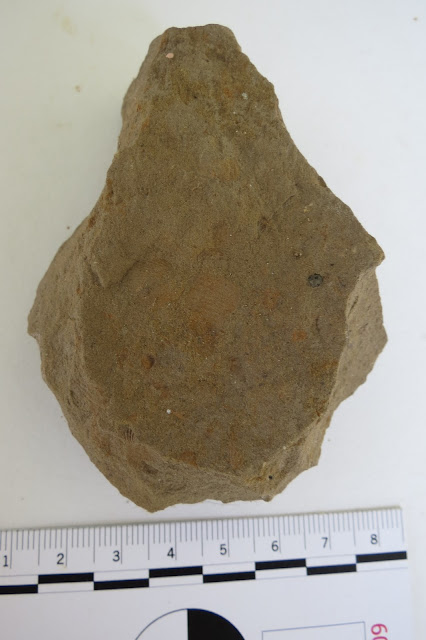A stone with edges trimmed into the desired shape using a buffer technique. From a hilltop site in unglaciated Licking County, Ohio, find by Ken Johnston.
The stone is shaped somewhat like a shell and small shell fossils are visible on one side. The creator may have noticed the fossils when making this artifact.
This artifact was found in site association with the first one presented
Find by Houck, Knox County, Ohio, the county north of Licking County. It is attributed to the American Archaic period, from approximately 8000 to 3000 years before present. This is more familiar to our visual senses as created by a human aesthetic. The buffer technique which created the "rough looking" artifacts is not as familiar to us, but I argue the same human sensibilities of proportion and shaping are at work here, just expressed in different stone working technologies. The finely worked flint seems to 'feature' or be centered on the creamy, white stone inclusion. This featuring is similar to the what appears to be shell fossil featuring on two artifacts from the same locale.
Buffer technique illustration:
Illustration © Archaeologische Berichten. Wouters, A., Franssen, C. and Kessels, A. (1981). Typologie van de artefacten van de Chopper Choppingtool Complexen. Archaeologische Berichten 10:19-117. Elst, NL. Fig. 2.
-kbj








Phi was easier identified by the early human because they were in the thick of the natural world. From the top of the mesa they observed the earth below and sky above.together they marked natures pattern's with stones. In this way the great spirit ways were known.
ReplyDeletei love rocks and artifacts. having said that, this portable rock art stuff is, in my opinion, a load of crap! i'm trying to be nice. it seems to me that everyone is seeing what they want to see( like faces of jesus in a streaked up window or the potato chip faces). that or you guys were just high when you found these so called artifacts. i'm in no way an expert and could be completely wrong, but the ridiculousness of these finds and what "experts" say they are supposed to be, to me, is astonishing. it just seems like you all are drinking the same koolaid. i thought primitive peoples were minimalists who carried with them only what was needed to survive. plus the same peoples who supposedly made these portable rock arts had the ability to make quite detailed and much more portable works of art from clay, so again why carry around a 5-10lb rock that looks like nothing but a rock(unless you're high) when you could carry around a much smaller, much lighter, and much more detailed piece of art? just my uneducated opinion.
ReplyDelete